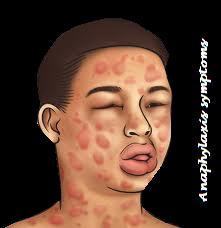Anaphylaxis
What is an anaphylactic shock?
Anaphylaxis (anaphylactic shock) is a life-threatening hyper-sensitized response, which can cause a shock or a sharp drop in peripheral blood pressure due to an allergic reaction. Anaphylaxis can occur after exposure to a particularized allergy-causing entity (allergen). In some cases, there may be a postponed response or anaphylaxis may occur without a clear trigger.[1][5]
If you’re with someone having signs of anaphylaxis, don’t wait to see whether symptoms resolve. Act calling emergency. In intense cases, untreated patients with anaphylaxis can lose life in half a minute. Antihistamine products, like (Benadryl), are not fully capable of controlling anaphylaxis. These medications can help relieve allergic symptoms, but are not suitable once the crisis has occurred.[1][2][3]
What should you do if you have a allergic reaction?
Anaphylaxis First Aid; The “8 steps” Manual
If you suspect that someone is having an allergic reaction or an anaphylactic shock, the following steps are mandated and can save lives.

- Directly call 911 or any local health care center.
- Ask the patient whether he is carrying or having a hormone auto-injector to obtain the allergic crises (for example, EpiPen, Twinject).[1][8][10]
- Listen to your patient and if the patient tells you that he or she wants to use an auto-injector, ask whether he or she needs your help. This is done by pressing down on the auto-injector against the thigh of the affected persons.[9]
- Help the patient to lie down on his or her back
- Make sure the patient’s clothing is fairly loose and make sure the person is breathing free
- Check responsiveness, ask the patient if he or she has a food allergy, and whether he’s or she’s allergic to any drugs, or foods, etc.
- If there are no signs of respiration, exhalation or pulse, you’ll need to perform CPR, Start CPR with 30 uninterrupted chest compressions before checking the airway and giving two rescue breaths – then repeat the process, do chest compressions at a rate of about 100 per minute until paramedics arrive.[7][8][9]
- Wait for the emergency to arrive.
After an anaphylactic shock, its likely for the symptoms to recur. Patient monitoring in the hospital is necessary, and the patient is required to stay in the hospital to undergo the diagnostic procedure, which may take hours to complete.
Symptoms
How do you know if you have anaphylaxis?
Common symptoms of anaphylaxis include:
1- Skin reactions including hives, itching, and flushed or pale skin
2- Swelling of the face, eyes, lips or throat
3- Blocked airways, wheezy and deep respiration
4- A slack and fast heartbeat, “arrhythmia”
5- Sickness, abdominal cramps or diarrhea
6- Dizziness, fainting or unconsciousness
How long do symptoms of anaphylaxis last?
Anaphylaxis is characterized by an acute onset, symptoms usually develop suddenly and progresses rapidly reaching peak within 2-30 minutes. Biphasic anaphylaxis is a second outbreak of anaphylactic symptoms that usually occur after a quiescent period of 1–8 hours. Rarely, protracted anaphylaxis may occur, with symptoms persisting for days.
Causes
What Causes Anaphylaxis?
In most cases, anaphylaxis is caused by exposure to an allergen. Common causative agents usually include:
1- Medications, antibiotics (Penicillins, cephalosporins, cotrimoxazole, sulfa drugs, tetracyclines, vancomycin, and ciprofloxacin), Antiseptics and disenfectants, NSAIDs (aspirin, ibuprofen, naproxen and diclofenac), and Anaesthetics, such as muscle relaxants and opioid analgesics.[2][4][1]
2- Food products (allergens), such as peanuts, walnuts, cashews, Brazil nuts, sesame, fish, dairy products, shellfish, and eggs.[4]
3- Stings from five insects, bees or honeybees, yellow jackets, wasps, hornets and firing ants.[6][10]
If you’ve had an allergic reaction in the near past, ask your doctor to prescribe an epinephrin or adrenaline auto-injector, to carry out with you in the nonoccurrence.
References
Anaphylaxis
Verified by: Dr.Diab (November 2, 2017)
Citation: Dr.Diab. (November 2, 2017). Anaphylaxis Causes Symptoms and First Aid. Medcoi Journal of Medicine, 15(2). urn:medcoi:article2844.












There are no comments yet
Or use one of these social networks